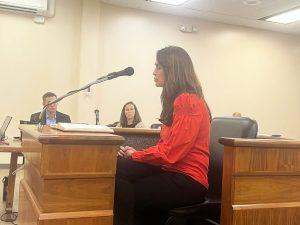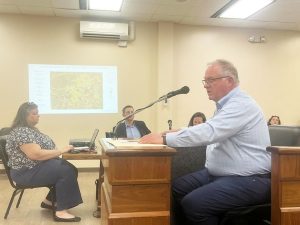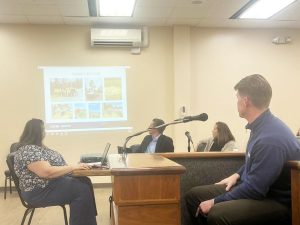Representatives from Charter Communications, Riverstreet Networks, and Appalachian Power (AEP) gave broadband updates to the Patrick County Board of Supervisors at its April 8 meeting.
Charter Director of State Government Affairs Joe Prater said the company’s two broadband projects are primarily in the southwestern corner of the county.

Charter will build 690 locations through the Virginia Telecommunication Initiative (VATI) state grant program, and 873 locations through the Federal Communication Commission (FCC) Rural Digital Opportunity Fund (RDOF).
“So, we’re kind of building them all at the same time. These numbers will change as we actually get out and build, when we see there are actually rooftops that are not serviceable locations or vice versa, but it’s looking to be a little bit over 1,500 locations as part of both of these initiatives,” he said.
In Charter’s build process, Prater said the company begins with a walk out.
“We literally will walk out, technically ride it, but we go every foot of the network we’re building to determine which best route – whether we want to go aerial or whether we want to go underground,” he said.
Every serviceable home and access pole space along those routes to further get an idea of what the build will entail will be surveyed. After that is complete, data will be forwarded to the design team, which will design the network on Google Earth.
Then, Prater said permits will be obtained and the design will go to the construction team.
“Build time is determined by our receipt of those permits. We work closely with all the permitting agencies, but this is the part where we have to wait to get those back,” he said.
As soon as the permits are received, Prater said Charter will move into the ‘make ready’ phase where it gets all the poles and everything else ready for the build.

“Then after that of course is the actual construction. This is by far the fastest part of the build. It’s these preliminary steps that take the most time. Of course, when construction’s complete, that’s when we activate the network,” he said.
Prater said the walkout for both VATI and RDOF have been 100 percent completed, and the company is currently in the permitting process.
On April 8, Prater said representatives from Charter, West Piedmont Planning District Commission (WPPDC), Patrick County and others did a site visit throughout the county.
Before the network is activated, Prater said Charter’s marketing team will send flyers to every street address that’s encompassed in the build, letting residents know the hookup options available.
“That and mailers, we’ll obviously do news ads, radio, television. We do the best we can to get the word out, but a lot of the times working with the county and a lot of those local community anchor institutions is the best way to get the word out,” he said.
Riverstreet Director of Business Development & Government Affairs Rob Taylor said the company has VATI 2022 and 2023 funds and RDOF funds.
“In total, we’ll be passing 8,376 locations in the county. Total route miles you’re looking at about 621 miles of fiber we’ll be installing. The project cost is just under $50 million at $49.5 million,” he said.

Taylor said Riverstreet will bring in $10.3 million, AEP will bring in about $14.1 million, and $1.5 million is in RDOF funds from the FCC. Patrick County has also committed approximately $2.1 million.
“We’re able to take the funding from Riverstreet, from AEP, and from the county and position that to secure about $21.2 million from VATI to get this project going. Our estimated cost is around just under $6,000 per location pass,” he said.
Taylor said AEP will run the middle mile, or the fiber that runs along the main routes and down the streets, while Riverstreet runs the last miles.
“So, those are going to be the drops basically coming from the poles to the homes, or it might be from the poles to the junction location where it might be feeding into a neighborhood that maybe the neighborhood has got all buried infrastructure so there’s no poles there,” he said.
Taylor said AEP and Riverstreet engineers are working on getting the construction timeline put together.
“As soon as I have a hard and committed to timeline from them, I’ll release that to the county as well as the board of supervisors and come back and do an update,” he said.
Taylor said this project is part of a three-county project for Franklin County, Henry County, and Patrick County.
“I know AEP has already started construction in Franklin County on that portion,” he said.
Citizens addressed to be served can go to www.MyRiverstreet.net and go to ‘The Future is Fiber’ and select their county to explore options. Those without internet can call Riverstreet’s toll-free number at (844) 238-0131.
Taylor said the service isn’t extended to the house or the business until an order is placed.
“Once someone places an order, then Riverstreet covers the first 2,000 feet of the cost to install fiber. So, if your house is within 2,000 feet of that pole line where the middle mile fiber is at, there’s no cost to you to sign up and get the service,” he said.
If there is more than 2,000 feet drop from the pole line to the house, then Riverstreet will extend a cost of $5 per additional foot.
“So, we still cover the first 2,000 feet, but it’s up to $5 per additional foot after that,” he said.
Taylor said Riverstreet participates in the Virginia Line Extension Customer Assistance Program (LECAP) program, where households that have a median income of less than $180,000 will have the additional cost of hookup covered by LECAP.
“There’s no cost to the homeowner at that time,” he said.
AEP External Affairs Manager Amanda Cox said crew are out in the field doing work like distribution analysis, fiber engineering, and environmental activities.
“We are nailing down last mile design with Riverstreet. We should have that, and I believe in the next couple of weeks you should see some start-stop construction along the way, but after that you should see some really solid progress when the designs come in,” she said.
Cox said AEP will work on making ready projects like pole replacement, ensuring that everything is in line for Riverstreet.
“We will be starting on the edge of Henry County, and we’ll also start Henry County’s right there on the edge of Patrick. So, we will build from the border of both of those segments and that will allow our resources to bounce back and forth between the counties to get work done more effectively and more efficiently,” she said.




